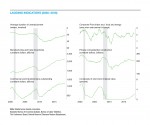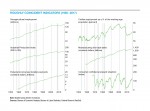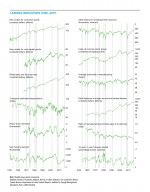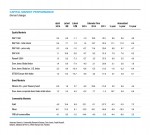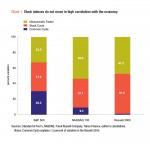December Business Conditions Monthly

AIER’s Business Cycle Conditions Leading Indicators index pulled back in November, dropping to 79 following an 83 in October and 88 in September. The Roughly Coincident Indicators index increased, moving back to 100, while the Lagging Indicators index tumbled 16 points to 67 from an 83 in October (see chart). The mixed results from the AIER business cycle indicators suggest continued economic expansion though signs of soft spots are developing. Still, they support a positive outlook with a relatively low, but rising, risk of recession.
The housing market continues to weaken as sales and new construction decline. The combination of rising interest rates and rising home prices is stifling demand and causing inventories to rise. The outlook remains weak.
Consumer price increases have moderated recently, and mixed performance among categories of goods and services suggests persistent, widespread increases in the general price level have yet to materialize.
Leading indicators declined for a second month in November
The AIER Leading Indicators index saw a second indicator among the 12 leading indicators turn negative in November. Debit balances in customers’ margin accounts declined for the third consecutive month in October, the latest month for which data are available. The consecutive declines turned the leading indicator from a neutral reading to a negative trend last month. However, other financial-related leading indicators remain positive. Real stock prices and the 10-year–1-year Treasury yield spread both remain in favorable trends.
The other leading indicator in a downtrend is housing permits. Housing permits turned downward in August after moving downward to a neutral trend in June. As discussed over the last few months, the housing market appears to be struggling with a combination of elevated home prices and rising interest rates. While affordability overall remains modestly favorable, it has become significantly less favorable over the past few years. With interest rates likely to drift even higher over coming months and quarters, the outlook for housing is weak. (See the detailed analysis below.)
Overall, 9 of the 12 leading indicators maintained a positive trend in November, with 2 trending lower (housing permits, and debit balances in margin accounts) while 1 indicator, average workweek in manufacturing, remains neutral.
The roughly coincident indicators also had one change in November as the employment-to-population ratio returned to a positive trend. That change pushed the overall index back to 100 from 92 in October. The Roughly Coincident Indicators index has oscillated between 92 and 100 since March 2017, hitting 92 in 5 of those months and scoring perfect 100s in 16. The employment-to-population ratio is one of the indicators with a natural boundary, and the indicator may be approaching that level. However, a tight labor market and rising wages might draw more people into the labor force, which would allow the employment-to- population ratio to trend higher for a little longer.
AIER’s Lagging Indicators index fell sharply in the latest month, posting a reading of 67 in November. That follows four consecutive months with a reading of 83 following three months at 92, from April through June. Real private nonresidential construction and commercial and industrial loans both moved from a positive trend to a neutral trend. There is some anecdotal evidence that construction may be hampered by a shortage of labor.
Overall, three indicators are trending higher, one is trending lower, and two are neutral. That compares to three trending higher, three trending neutral, and none trending lower in October. Duration of unemployment remains the one indicator in a negative trend.
The three AIER business cycle–indicator indexes are still in favorable territory, suggesting a continued positive economic outlook with a relatively low probability of recession in the coming months. However, some patches of weakness are emerging, particularly in housing. Vigilance is warranted given the high level of uncertainty regarding trade and fiscal policy as well as the overall interest rate environment.
Housing outlook continues to darken
The AIER housing-permits leading indicator has been in a downtrend since August after weakening to a neutral trend in June. The latest data from the Census Bureau show total permits fell 0.6 percent in October to 1.263 million and are off 6.0 percent from October 2017. Single-family permits also fell 0.6 percent, to 849,000, while permits for two- to four-family units were down 5.0 percent and permits for five or more units were unchanged at 376,000. From a year ago, single-family permits are down 0.6 percent while two- to four-family units are up 8.6 percent and permits for five or more units are off 17.2 percent.
Total housing starts rose 1.5 percent in October to a 1.228 million annual rate but are down 2.9 percent from a year ago. The dominant single-family-homes segment, which accounts for about three-fourths of new home construction, fell 1.8 percent for the month to a rate of 865,000 units; the segment is 2.6 percent below the October 2017 level. Starts of multifamily structures with five or more units jumped 6.2 percent to 343,000 but are off 4.5 percent from a year ago.
Along with the weakness in housing permits and starts, home builder sentiment from the National Association of Home Builders plunged in the latest survey. The index came in at 60, down from 68 in October. That is down from a recent peak of 74 in December 2017. Among the three components of the overall index, the current single-family sales index fell 7 points to 67 while the expected-sales component lost 10 points, to a reading of 65. Both indexes had been as high as 80 over the past year. The traffic-of-prospective-buyers component came in at 45 in November, down from 53 in the prior month and well below the 58 reading in December 2017.
The drop in the current-sales index is consistent with the drop of 8.9 percent in sales of new single-family homes. Sales came in at 544,000 in October versus the 597,000 pace in September. From a year ago, sales are off 12.0 percent and are down 23.6 percent from a recent peak in November 2017.
Total inventory of new single-family homes for sale rose 4.3 percent in October and is 17.5 percent above the year-ago level. That increase has pushed the months’ supply (inventory times 12 divided by the annual selling rate) to 7.4, the highest since November 2010.
The S&P Case-Shiller home-price index rose 5.5 percent for the 12 months through September 2018. That is down from a recent peak pace of 6.5 percent for the 12-month period through March. However, home prices have been rising since the end of 2011, gaining a total of 49.7 percent, or an annualized pace of more than 6 percent. Furthermore, home prices are more than 10 percent above the peak level during the housing bubble of the late 2000s. Mortgage rates have also been on the rise, with the effective rate on Federal Housing Administration mortgages rising from 3.55 percent in October 2016 to 5.33 percent currently.
The combination of rising home prices and higher interest rates is weighing on home affordability. Affordability has been trending lower after surging from 2009 to 2012, when a combination of extraordinarily low interest rates and falling home prices made for a buyer’s market.
For the housing market overall, affordability remains marginally favorable, though the declining trend is likely to continue. Sales are unlikely to move significantly higher in the coming months, and new-home construction is unlikely to contribute significantly to growth in gross domestic product in coming quarters.
Consumer price increases are moderating
The personal consumption expenditures (PCE) price index, the measure preferred by the Federal Reserve, rose 2.0 percent for the 12 months through October. That is down from a 2.3 percent pace around midyear. That aggregate index masks a wide range of price changes among the different types of goods and services. Durable-goods prices are down 1.4 percent over the same period and are down an annualized 2.1 percent over the last five years.
Nondurable-goods prices are up 2.0 percent over the past year but are flat over the past five years. Nondurable-goods includes energy commodities such as gasoline and other fuels. The index for gasoline and other fuels is notoriously volatile, rising 16.3 percent over the past year but declining at an annualized rate of 2.9 percent over the last five years. Food, another category known for volatility, has been rather tame. Food-goods prices, primarily groceries, have been essentially flat over the last five years while food services (restaurants) have experienced sustained increases in recent years, rising at a 2.5 percent annualized rate.
Many other services categories are experiencing persistent increases as well. Services prices overall are up 2.5 percent from a year ago and 2.3 percent over the last five years. International trade and productivity gains that have helped restrain prices for goods are far less influential for consumer services, and with a tight labor market and rising wages, price pressures are likely to continue for consumer services.
Still, the takeaway is that with flat or falling prices for many goods, persistent surging increases in aggregate price measures remain unlikely.
Money and credit growth are decelerating
M2 money-supply growth came in at 3.7 percent for the 12 months through October. That is down from 3.9 percent in the prior month and significantly slower than the recent peak pace of 7.5 percent in October 2016. M2 growth has been relatively moderate compared to historical rates. Over the last three years, M2 has increased at a 5.4 percent annual rate versus 5.5 percent over the last 5 years, 6.0 percent over the last 10 years, and 6.2 percent over the last 20 years.
Total lending by commercial banks has also been decelerating recently, growing by 4.4 percent for the 12 months through October. That is down from a 5.0 percent pace as of June 2018 and well below the 7–8 percent growth rate during most of 2015 and 2016. Over the last five years, bank lending has increased at an annualized rate of 6 percent. For the 30 years prior to the Great Recession, bank lending grew at an 8.0 percent annualized rate. Sharp contractions during and immediately after the recession led to a 10 percent decline in total loans and leases outstanding. Total commercial bank credit is currently about a third greater than the prior peak level in 2008.
[pdf-embedder url=”https://www.aier.org/wp-content/uploads/2018/12/BCM_December_2018.pdf“]